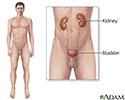External incontinence devices
Condom catheter; Incontinence devices; Fecal collection devices; Urinary incontinence - devices; Fecal incontinence - devices; Stool incontinence - devices
External incontinence devices are products (or appliances). These are worn on the outside of the body. They protect the skin from constant leakage of stool or urine . Certain medical conditions can cause people to lose control of their bowel or bladder.
Leakage of stool or urine
The following organizations are good resources for information on incontinence. Fecal incontinence:The American College of Obstetricians and Gynecolo...

Information
There are several products available. The features of these different products are listed below.
FECAL INCONTINENCE DEVICES
There are many types of products for managing long-term diarrhea or fecal incontinence . These devices have a drainable pouch attached to an adhesive wafer. This wafer has a hole cut through the center that fits over the anal opening (rectum).
Fecal incontinence
Bowel incontinence is the loss of bowel control, causing you to pass stool unexpectedly. This can range from sometimes leaking a small amount of sto...

If put on properly, a fecal incontinence device may stay in place for 24 hours. It is important to remove the pouch if any stool has leaked. Liquid stool can irritate the skin.
Always clean the skin and apply a new pouch if any leakage has occurred.
The device should be applied to clean, dry skin:
- Your health care provider may prescribe a protective skin barrier. This barrier is usually a paste. You apply the barrier to the skin before attaching the device. You can put the paste in the skin folds of the buttocks to prevent liquid stool from leaking through this area.
- Spread the buttocks apart, exposing the rectum, and apply the wafer and pouch. It may help to have someone help you. The device should cover the skin with no gaps or creases.
- You may need to trim the hair around the rectum to help the wafer stick better to the skin.
An enterostomal therapy nurse or skin care nurse can provide you with a list of products that are available in your area.
URINARY INCONTINENCE DEVICES
Urine collection devices are mainly used by men with urinary incontinence . Women are generally treated with medicines and disposable garments such as Depends.
Urinary incontinence
Urinary (or bladder) incontinence happens when you are not able to keep urine from leaking out of your urethra. The urethra is the tube that carries...

The systems for men most often consist of a pouch or condom-like device. This device is securely placed around the penis . This is often called a condom catheter. A drainage tube is attached at the tip of the device to remove urine. The drainage tube empties into a storage bag, which can be emptied directly into the toilet.
Penis
The penis is the male organ used for urination and sexual intercourse. The penis is located above the scrotum. It is made of spongy tissue and bloo...

Condom catheters are most effective when applied to a clean, dry penis. You may need to trim the hair around the pubic area so the device attaches better.
You must change the device at least every other day to protect the skin and prevent urinary tract infections . Make sure the condom device fits snugly, but not too tightly. Skin damage may occur if it is too tight.
Urinary tract infections
A catheter is a tube in your bladder that removes urine from the body. This tube may stay in place for an extended period of time. If so, it is cal...

References
Catheter-associated urinary tract infections: definitions and significance in the urologic patient. American Urology Association. www.auanet.org/common/pdf/education/clinical-guidance/Catheter-Associated-Urinary-Tract-Infections-WhitePaper.pdf . Accessed June 16, 2016.
Fecal incontinence. First Consult . 2013. www.clinicalkey.com/#!/content/medical_topic/21-s2.0-2001169 . Accessed June 16, 2016.
Newman DK, Burgio KL. Conservative management of urinary incontinence. In: Wein AJ, Kavoussi LR, Partin AW, Peters CA, eds. Campbell-Walsh Urology . 11th ed. Philadelphia, PA: Elsevier; 2016:chap 80.
Rao SSC. Fecal incontinence. In: Feldman M, Friedman LS, Brandt LJ, eds. Sleisenger and Fordtran's Gastrointestinal and Liver Disease . 10th ed. Philadelphia, PA: Elsevier Saunders; 2016:chap 18.
Review Date: 5/23/2016
Reviewed By: Jennifer Sobol, DO, urologist with the Michigan Institute of Urology, West Bloomfield, MI. Review provided by VeriMed Healthcare Network. Also reviewed by David Zieve, MD, MHA, Isla Ogilvie, PhD, and the A.D.A.M. Editorial team.


